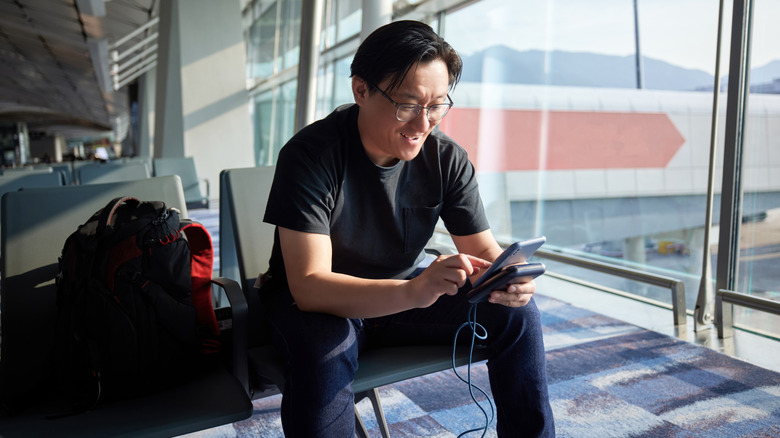Why It's Crucial For Tourists To Double-Check Their Luggage And Power Bank Before A Trip To Asia
If you're catching a flight to Asia, take a second look at your baggage and electronic devices before heading to the airport. Many airlines have recently stepped up screening for external battery packs and power banks across the continent due to an accident that could have been deadly, had it occurred a few moments — or hours — later in the air.
Incidents of faulty power banks sparking on flights have become more common, with the Federal Aviation Administration (FAA) recording 89 in 2024. However, the seriousness of power banks on flights became more evident on January 28, 2025, during a major accident at Gimhae International Airport in Busan, South Korea. While Air Busan flight 321 was moving away from the gate, flight attendants heard a "crackling sound" from the overhead bin before smoke and flames filled the cabin, The Korea Herald reported. Even though all 176 passengers and crew evacuated without loss of life, some passengers were injured. South Korea's Aviation and Railway Accident Investigation Board conducted a preliminary investigation, with investigators believing that the fast-spreading fire likely started from a passenger's power bank stored above their seat. In light of the accident, Korea has added new security rules, as have other regional airlines in Asia.
Since there is no international regulation on power bank usage and storage on international flights in cabin luggage, passengers will have to check their airline's policies in advance or may be stuck "raw dogging" their flight. One rule of thumb is to stick with batteries and power banks that are under 100 Wh (27,000 mAh) when packing your carry-on. In the future, you should also consider bringing a small roll of insulated tape or an extra transparent plastic bag for each battery, depending on where your travels lead.
What to expect at airports and on board
As if flying internationally isn't complicated enough, passengers who aren't prepared or aware of the new power bank rules may have to repack their bags at the gate. If you are flying in Asia, expect not to use your power bank in flight, plan accordingly, and be a great passenger because flying safely is everyone's responsibility. Since March 2025, several Asian countries have tightened regulations for transporting power banks on flights. These batteries are not allowed in the overhead bins on Air Asia, Malaysia Airlines, and Hong Kong-based airlines and must be kept under the seat or in a seatback pocket.
South Korea has gone further, requiring power banks to be kept in a plastic bag or taped during flights, as well as requiring travelers to remove power banks from their luggage and have them checked by screeners for the flight. Power banks also are not allowed to be used and must be carried on the person or in the seatback pocket for the duration of the flight.
Other airlines in Asia have also limited the use of batteries and power banks on board flights. Currently, Taiwan's major airlines, airlines based in China, Air Astana, Thai Airlines, Singapore Airlines, and Scoot prohibit the use of power banks in flight. This doesn't mean you'll have no access to juice, as you can still use the airplane's USB-A, USB-C, or power outlet (if provided) to charge devices (but not power banks). However, if you're flying the world's best ultra-low cost carrier, which doesn't typically offer charging ports, it may be best to go old-school and bring a good book.

